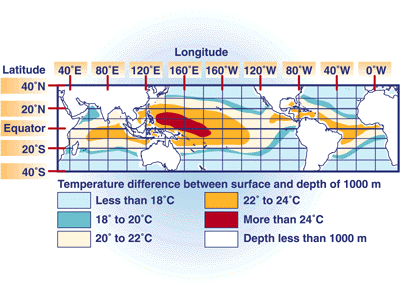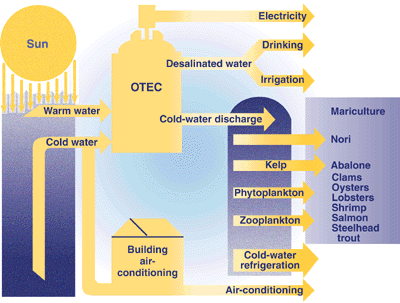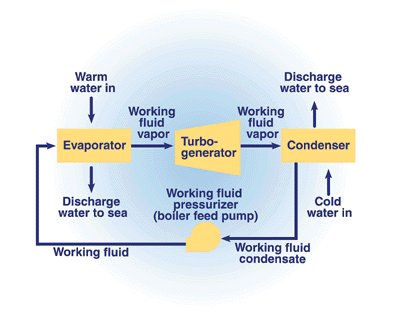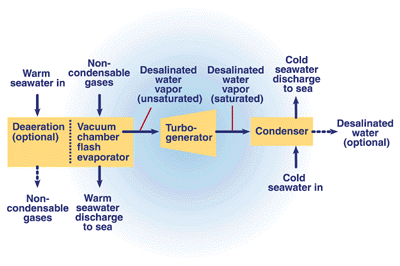Thermal energy harvest

There are principally two ways to harvest energy from the ocean, mechanically (think waves and tides) and thermally (think solar energy stored in the water and temperature difference between deep ocean and the surface.) Ocean Energy Thermal Conversion (OETC) has been around well over 100 years and works either in an open or closed cycle (works just like organic rankine cycle geothermal systems.) The prospects of OETC were first proposed in 1881 by Jacques Arsene d’Arsonval, a French physicist.
The concept was first proved in 1930 by Georges Claude off the coast of Cuba with a 22 kilowatt unit and later off the coast of Brazil with a 10,000 ton cargo vessel. Both plants were destroyed in storms before either had demonstrated net power production (producing more energy than the system consumes during operation.) In 1956 the French made another attempt at OETC off the Ivory Coast planning a 3MW facility. While construction was started, it was never completed due to high costs.

Illustration of an Ocean Thermal Energy Conversion plant
The first oil crisis spurred the US into the act in 1974 when the Natural Energy Laboratory of Hawaii Authority was established. The group created a 52 kilowatt mini-OETC plant that was moored a couple of miles off the coast that was a net producer (15 kilowatts,) enough to operate the ship’s electrical systems. In 1999, the group successfully tested a 250 kilowatt system. Both of these experiments were closed or binary approaches.

OTEC Closed Cycle Plant Illustration
In 1984, NELHA created a 50 kilowatt open system, boiling seawater at low pressures, that had efficiencies as high as 97%. It turns out the open approach also has the interesting by-products of nearly pure fresh water, very cold sea water, and the solids left by evaporation which can be rich in up to 57 different trace minerals. This could have a use in desalination, mining, and aquaculture in addition to simply producing power.

OTEC Open Cycle Plant Illustration
The National Renewable Energy Lab has ceased all work in this area, this isn’t uncommon in today’s DoE as they seem to only care about nuclear power and the elusive “clean coal” technology. But, private firms are continuing to explore this concept and seem to be moving ahead slowly. NELHA remains the only site with active use of OETC, though it is relatively small scale and used principally for aquaculture.
Commercial development is still underway with proposals for 100MW sea power plants by Sea Solar Power Inc. and SEA02’s proposal for an ocean-based, sustainable city called Townsville.









[…] already explored Ocean Thermal Energy Conversion and the reservoir approach to mechanical ocean energy harvest, it’s time to look at the wave […]
Abbiamo richieste da città costiere interessate alla tecnologia “energy island” Vorremmo maggiori notizie in merito . Per una città di 35000 abitanti è sufficiente una “isola” ?? Che cosa può produrre tra energia, acqua potabile, idrogeno, eolico ed in quali quantità medie giornaliere al fine di poter sviluppare un project financing per il finanaziamento dell’operazione ?? Nel medio mare Adriatico possono esserci le condizioni favorevoli eventualmente sostituendo le sonde sottostanti con turbine sottomarine ??? Grato per una risposta. Cordialità . Gianni Benetti